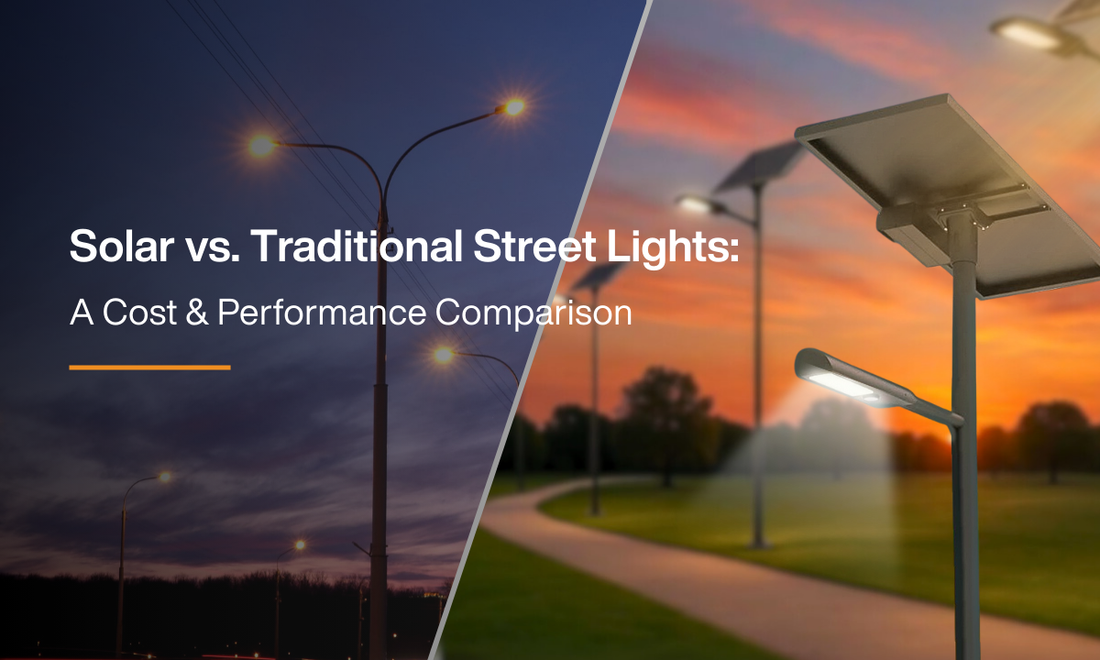
Solar Street Lights vs Traditional: Cost, ROI & Efficiency
Cities, contractors, and HOAs considering infrastructure upgrades are always concerned about one thing: how do solar streetlights truly measure up against traditional grid‑tied setups?
Although traditional streetlights were the norm for decades, the swift improvements in solar tech and LED streetlight efficiency has reversed the economics.
This resource considers costs, performance, maintenance, and ROI of solar street lights & traditional lighting. Along with that, it also mentions how Beyond Solar's SolePole, Beacon, Pollux, and Vitality models compare to traditional lighting.
1. Solar street light vs Electrical: Initial Costs vs. Overall Project Expenses
Conventional street lighting might seem less expensive on the surface, but it has hidden costs. Trenching, conduit, cabling, and utility dependence frequently cost thousands per fixture. In one hospital construction project, not having to trench through a roadway saved over $500,000 in initial costs.
Solar lighting has more per-unit hardware expenses but does not require trenching at all, reducing overall project budgets significantly. Hence, LED street light efficiency is far better.
-
Traditional: $3,000–$5,000 per fixture installed (trenching and cabling included)
-
Solar: $2,500–$4,000 per fixture installed (no trenching, quicker deployment)
2. Energy Bills and Long-Term Savings
Traditional streetlights need constant power from the grid. Each fixture imposes $150–$250 yearly on municipalities in utility bills. Solar lights, energized by sunlight, cost nothing for energy. Cities can save millions over a 10‑year span on thousands of lights. Hence ROI of solar street lights is way better.
3. Performance: Brightness and Reliability
Early solar lights were known to be dimmer, but modern designs match and sometimes even beat traditional lighting. Over the years, LED streetlight efficiency has only gone up.
If we take a look at Beyond Solar's Beacon and SolePole Dual systems, they provide lumen outputs comparable to standard HID or LED lighting. They also provide accurate optics and color temperatures, that comply with IESNA standards. With battery backup, solar lights remain illuminated during power outages something that traditional lights are unable to do.
4. Maintenance & Lifecycle
When it comes to the maintenance of solar vs grid lights, there are several points of failure in conventional systems. Bulbs, ballasts, underground wiring, and transformers need roadwork or coordination with utilities for repairs.
Solar lights, on the other hand, are autonomous. New LiFePO₄ batteries can last 5–10 years, and LEDs easily last over 100,000 hours. Maintenance needs are reduced to cleaning panels and periodic battery replacements, significantly reducing O&M expenses hence, ROI of solar street lights is also better.
5. Environmental and Sustainability Considerations
LED street light efficiency aligns perfectly with corporate and municipal renewable energy initiatives. By eliminating grid dependence, cities minimize carbon emissions, promote climate ambitions, and enhance public image.
Beyond Solar systems also have recyclable materials and power-efficient LEDs to minimize overall environmental impact.
6. Beyond Solar Products vs. Conventional Systems
- Solar Street Lights (such as SolePole Dual-style systems): Single-unit solar lighting that illuminates arterial roads or highway corridors with zero trenching, providing redundancy and high lumen output.
- Solar Sign Lights (eg, Spark Pro): Smart, off-grid sign lighting without the wiring while providing visibility and safety for traffic signs and wayfinding.
- Solar Pathway Lights & Bollard Systems: Suitable for recreational areas, walkways, and landscaped areas durable but pleasant lighting without electricity infrastructure.
- Solar Flood & Wall Pack Lights: Effective for illuminating building exteriors, parking lots, and security areas, completely solar powered for maximum availability during power outages.
- Solar Portable Lights and Spot Lights: Versatile, portable lighting solutions, ideal for temporary applications, event deployments, and maintenance activities, all without needing the grid.
These product lines compete head-on with conventional solutions with zero cost of utility, modular installation, and low maintenance.
7. Case Example: Cost Avoidance with Solar
In a suburban neighborhood, trenching to install grid lighting across a collector road was priced at $600,000. By using Beacon and Pollux lighting fixtures from Beyond Solar instead, the contractor provided similar lighting with no trenching, eliminating most of the initial expense. Our LED streetlight efficiency saves the HOA $50,000+ each year in electricity bills.
8. Where Solar is Replacing Traditional Lights
Cities across the country are switching to solar. Dallas, Phoenix, Orlando, Baltimore, and San Diego have all tested or expanded solar street lighting programs. Along coastlines such as Ocean City, off-grid lights stay lit during outages, demonstrating their strength over grid systems. As increasing numbers of municipalities recognize ROI of solar street lights and performance, solar is rapidly emerging as the new standard.
Frequently Asked Questions
-
Are solar street lights brighter than conventional ones?
Yes. With models like Beacon and SolePole Dual, lumen outputs rival HID and LED grid fixtures while offering uniform distribution.
-
Which is cheaper: solar or traditional street lights?
While solar has higher upfront hardware costs, it avoids trenching and eliminates electricity bills, making it cheaper in the long run..
-
What about cloudy days or winter conditions?
Solar lights include 2–4 nights of battery power . Beyond Solar’s systems are engineered for year‑round reliability.
-
Do solar lights require regular maintenance?
No. Simple cleaning and a battery replacement every 5–10 years are usually all that's needed.
-
How long do conventional vs. solar lights last?
Standard LEDs operate for ~50,000 hours; Beyond Solar LEDs operate for up to 100,000 hours. Batteries provide 5–10 years of reliable service.
-
How can Beyond Solar assist me with my transition?
Beyond Solar offers photometric design, financing consultations, and U.S.‑based service using tried‑and‑true products such as Mantis, Cube, Lune and SunTrack.
Conclusion
The choice between solar street light vs electrical lighting is a decision based on lifecycle cost, reliability, and sustainability. Whereas grid lighting binds municipalities into utility charges and trenching costs, ROI of solar street lights is way better along with quick installation, sturdy operation, and better performance.
With Beyond Solar's lineup of SolePole Dual, Beacon, Pollux, and Vitality systems, contractors and city officials have access to technology that surpasses traditional lighting in terms of cost, safety, and sustainability.
